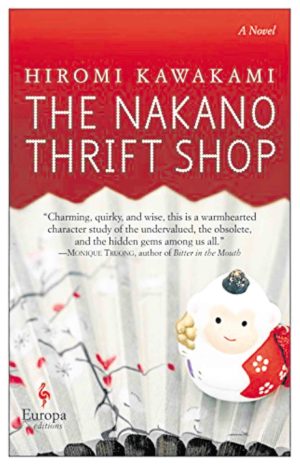
That is exactly what happens in Japanese author Hiromi Kamakami’s “The Nakano Thrift Shop” (translated by Allison Markin Powell; Europa Editions, New York, 2017, 230 pages).
Originally published in Japan in 2005, “Nakano” follows the everyday events at the titular thrift shop.
It should be emphasized that nothing truly unusual happens there. There are no mysterious phenomena. To be honest, there aren’t even any really enigmatic people there.
Instead, Kamakami presents us with a company of characters so realistic that you’ll sometimes wonder if “Nakano” has somehow crossed into nonfiction.
The Nakano Thrift Shop is exactly what you think it is: A thrift shop where secondhand items are bought and sold. The more secondhand the item, so much the better.
“Nakano” is built around the experiences of Hitomi Saganuma, the shy shopgirl who longs to be loved yet fears what she doesn’t understand. She carries on a halting flirtation (if you can call it that) with a no-nonsense (and even less vocal) colleague Takeo.
Presiding over the proceedings at the shop is the grumpy boss, Haruo Nakano. He loses himself in running the store when he’s not running after women.
Occasionally intercepting him are his regular girlfriend, the long-suffering Sakiko, and his artist sister with the penchant for blurting out revelations, Masayo.
Immensely popular
Kawakami is an immensely popular presence in Japan, especially after her 2012 novel “Strange Weather in Tokyo” joined the ranks of Haruki Murakami and Banana Yoshimoto.
Kawakami writes in a spare, observational manner that hews similar to the other two’s prose. But unlike them, Kamakami’s fiction is rooted in the reality that lies beneath the usual.
There are no tricks here, no hidden equivalences. The prose is clear and spare, the realizations moving.
“Nakano” moves forward as one item after another arrives at the shop to be sold. Mr. Nakano inevitably guesses its history and value. Takeo grumbles and moves the item. Hitomi wonders after it.
The items themselves, like the events in the shop, are seemingly ordinary. They’re not. There’s a lighter that may not be what it seems. There’s a standee for a 1980s actress peddling a sewing machine. There’s a flimsy dress that suddenly becomes useful. There’s even a porcelain bowl supposedly with a curse on it.
These small stories become topics for Hitomi and company to chew on.
Hitomi chronicles what happens in the shop day by day, and, ultimately, “Nakano” becomes rooted in the truths behind the lives of those who work there.
“It seems to me [that] everyone—men and women, old and young—loses weight when a love affair is over,” Hitomi thinks.
Relationships are evaluated. People die. Everything is filtered through the life of the Nakano Thrift Shop. The shop becomes more of a character in itself than a setting.
Most precious
Readers will grow to care about these quirky characters, making “Nakano” an utterly charming little book.
There is a powerful nostalgia attached to the happenings in “Nakano,” like the strong feelings one gets when thinking about the most memorable times in ones life.
The oddest details jump out at you and they feel as if they happened just yesterday.
This is the same sense of memory that Hiromi Kawakami employs in “The Nakano Thrift Shop”—a sense that what’s always around you is the most precious. Take it away and, after a while, you realize what you’ve truly lost.
It is a realization obscured by the daily clutter and detritus. It is as Hitomi herself wonders: “Ours is a strange world in which whatever was new and neat and tidy diminished in value.”
Available in paperback from Fully Booked and National Book Store.